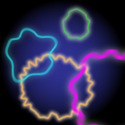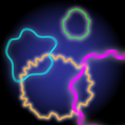String theory on the brane
M2-branes are objects that arise in a theoretical framework, called M-theory, which is conjectured to unify all string theories. Accumulated evidence suggests that at low energies, M-theory has a unique well-known 11-dimensional Lagrangian description that includes gravity, among other interactions. In this description, M2-branes are membranelike classical solutions that span two dimensions in space.
Branes of any dimension often yield surprises when considered in multiple numbers. For instance, stacks of certain branes in string theory are described in terms of supersymmetric gauge theories. This relationship of stacks of branes and gauge theories has led to a variety of important results and insights into gauge theories themselves.
Jonathan Bagger (The Johns Hopkins University) and Neil Lambert (King’s College, London) found that multiple M2-branes are described most naturally in terms of a new mathematical structure that they call a three-algebra. Writing in Physical Review D, Bagger and Lambert build on their previous work to consider more general M2-brane configurations. The new theories they construct are based on less restrictive three-algebras than was thought possible previously and open up intriguing new directions.
The results reported here have implications both for a better understanding of M-theory and the low-energy dynamics of gauge theories in 2+1 (space+time) dimensions. – Ansar Fayyazuddin





